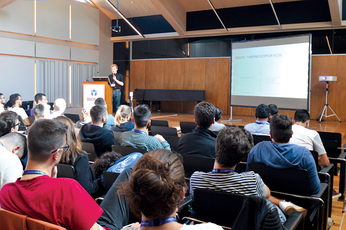Space science for everyone at the Open Source CubeSat Workshop
CubeSat Workshop

The CubeSat community gathered in Athens, Greece to explore the possibilities for open hardware and open source software in space.
The Open Source CubeSat Workshop took place at the Athens Conservatory in Athens, Greece on October 14-18, 2019 [1]. The LibreSpace Foundation [2], which is sponsored by the European Union and the European Space Agency, organized the event. The general philosophy of the LibreSpace Foundation is to remove the barriers of confidentiality and secrecy involved in satellite development and to facilitate sharing of information on how to build and operate CubeSats.
CubeSats are miniature satellites used for scientific research in space [3] [4]. The most basic CubeSat is a 10cm cube that weighs a maximum of 1.33 kilograms (2.9 pounds). The tiny CubeSat is small enough to ride along as a secondary payload on government and commercial space launches. CubeSats have also been launched from the International Space Station. In all, more than 1,100 CubeSats have been launched into space, carrying a variety of experiments – many created by university students and amateur scientists.
[...]
Buy this article as PDF
(incl. VAT)
Buy Linux Magazine
Subscribe to our Linux Newsletters
Find Linux and Open Source Jobs
Subscribe to our ADMIN Newsletters
Support Our Work
Linux Magazine content is made possible with support from readers like you. Please consider contributing when you’ve found an article to be beneficial.

News
-
Say Goodbye to Middle-Mouse Paste
Both Gnome and Firefox have proposed getting rid of a long-time favorite Linux feature.
-
Manjaro 26.0 Primary Desktop Environments Default to Wayland
If you want to stick with X.Org, you'll be limited to the desktop environments you can choose.
-
Mozilla Plans to AI-ify Firefox
With a new CEO in control, Mozilla is doubling down on a strategy of trust, all the while leaning into AI.
-
Gnome Says No to AI-Generated Extensions
If you're a developer wanting to create a new Gnome extension, you'd best set aside that AI code generator, because the extension team will have none of that.
-
Parrot OS Switches to KDE Plasma Desktop
Yet another distro is making the move to the KDE Plasma desktop.
-
TUXEDO Announces Gemini 17
TUXEDO Computers has released the fourth generation of its Gemini laptop with plenty of updates.
-
Two New Distros Adopt Enlightenment
MX Moksha and AV Linux 25 join ranks with Bodhi Linux and embrace the Enlightenment desktop.
-
Solus Linux 4.8 Removes Python 2
Solus Linux 4.8 has been released with the latest Linux kernel, updated desktops, and a key removal.
-
Zorin OS 18 Hits over a Million Downloads
If you doubt Linux isn't gaining popularity, you only have to look at Zorin OS's download numbers.
-
TUXEDO Computers Scraps Snapdragon X1E-Based Laptop
Due to issues with a Snapdragon CPU, TUXEDO Computers has cancelled its plans to release a laptop based on this elite hardware.


